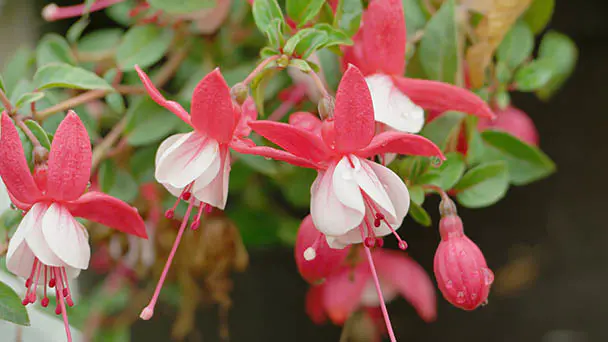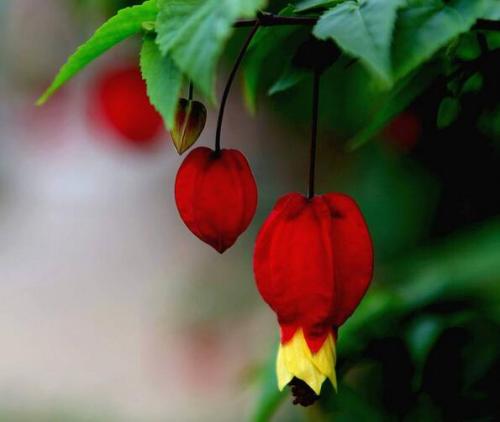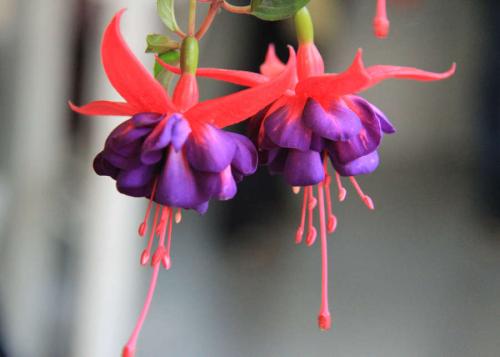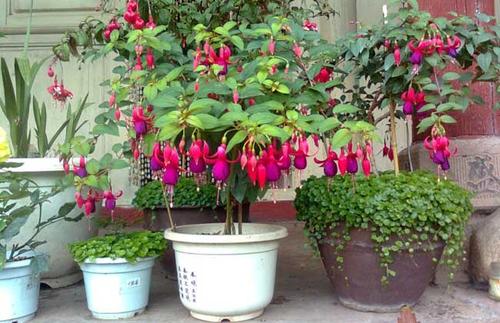Hybrid Fuchsia (Hummingbird Fuchsia) Profile
Written by Maggie
Nov 10 2021

Hybrid Fuchsia (Hummingbird Fuchsia) is an evergreen shrub. Hybrid Fuchsia plant height can reach 2 meters in the open air and 1 to 1.5 meters in the pot. It has luxuriant leaves, soft branches and arched branches, and a beautiful appearance. The stalk of the flower is long and thin, hanging high, the stamens extend beyond the corolla, and the flowers hang high like palace lanterns. Hybrid Fuchsia shows its cuteness in its unique form.
Hybrid Fuchsia picture

Hybrid Fuchsia Quick Info
| Botanical/Scientific Name | Fuchsia Hybrida |
| Common Name | Hummingbird Fuchsia |
| When to Grow/Bloom/Harvest | The bloom period is usually 12 weeks from late spring to early fall |
| Uses | Summer flowering displays in containers, hanging baskets or flower borders |
| Origin | South America |
| Light Care | Morning sunlight and afternoon shade |
| Soil Care | Soil with a pH level of 6 to 7 |
| Temperature Care | Daytime temperatures well below 80 degrees F. (27 C.) |
| Humidity Care | Aim to maintain 40% relative humidity or higher |
| Watering | Be watered when they dry out |
| Pruning Care | Prune your hardy fuchsias in late March or April |
| Fertilizer Care | Fertilizer every 7 to 10 days |
| Propagation | Fuchsia cuttings |
| Toxic | Not toxic |
| Flower Color | Purple Red Orange White Pink |
Morphological characteristics of Hybrid Fuchsia
Hybrid fuchsia is a unique plant with slender upright leaves similar to the mountain lily, which, when rolled up, looks like an ancient scroll. Near the flower stem there are things like whiskers wrapped around the flower stem to keep it upright.
Each flowering period of the flowers can only be maintained for about a week, in the upper part of the stem of the leaves will bulge out look like wind bells, also like a bell-shaped flowers, the shape of the flowers is long, probably like 7-9 turns of the natural drooping. The color of flowers is red or orange.
Hybrid Fuchsia is an epiphytic evergreen shrub with a height of about 1m. The branches have densely bristled. Leaves are ovate-lanceolate, sub fleshy. Inflorescences are axillary, subumbellata, flowers 4-6 (8), corolla tube red, lobes triangular, pale green.
Hybrid Fuchsia distribution area
Hybrid Fuchsia grows in northern and western Yunnan, about 2,200m above sea level, epiphytic on old trees or rocks. It is also found in northern Myanmar.
Hybrid Fuchsia was originally produced in Brazil, Uruguay and other places in South America. Our country Fujian, Zhejiang, Jiangsu, Hubei, Beijing, Liaoning and other places each big city has cultivation.
Hybrid Fuchsia Care in Detail
Hybrid Fuchsia Watering
During the growth and maintenance of hybrid Fuchsia, we should water reasonably, usually after the soil is dry, and water every 3-7 days during the growth period. Watering can be reduced during high temperatures in summer and too low temperatures in winter. Every time hybrid fuchsia is watered, we should pay attention to the water volume to ensure that it can be watered thoroughly. We must not water too much. Before watering, take out the tap water to dry, volatilize the chlorine inside, and maintain the water temperature. At the same time, we should also pay attention to rational fertilization during hybrid Fuchsia maintenance.
Hybrid Fuchsia Soil
We can apply thin fertilizer every 15 days or so during the growth period of hybrid Fuchsia, and phosphorus and potassium fertilizer before flowering. We should also provide suitable soil for hybrid Fuchsia, preferably acid soil with loose air permeability, good drainage and rich nutrition.
Hybrid Fuchsia Light
The most important thing for us to maintain hybrid Fuchsia is to have appropriate light. It is impossible to have too much or too strong light. We can give more light in a cool and humid environment. If the temperature becomes higher, we should reduce the light. Exposure to sunlight or excessive direct sunlight is easy to cause yellow leaves.
Hybrid Fuchsia Temperature
It is most appropriate for us to maintain the temperature of hybrid Fuchsia at about 20 degrees. It is easy to hang up if the temperature is too high or too low. It is most appropriate to maintain the minimum maintenance temperature at 10 ~ 15 degrees. Maintaining such temperature in winter is conducive to the proper dormancy of hybrid Fuchsia and easy flowering in the coming year.
Hybrid Fuchsia Humidity
Hybrid Fuchsia is very afraid of the dry humidity environment. If the soil is dry, it is easy to damage the roots. During the growth period of hybrid Fuchsia, the soil should be kept slightly moist. During the maintenance period, the roots must be kept cool and slightly moist. Watering should be reduced only after the weather becomes cold. Watering should be stopped when the temperature drops rapidly in winter.
Hybrid Fuchsia Fertilizer
When we fertilize hybrid Fuchsia, we need different fertilizers in each period. Because it grows fast and blooms many times, it can be applied with some thin cake fertilizer during the growth period. The best time is once every 10 days. At the flowering stage, a little liquid fertilizer with high phosphorus and potassium content should be applied to it.
Hybrid Fuchsia grows fastest in spring, so it should be watered once or twice during flowering. At this time, it's better to make the basin soil wet than too dry. Then, when loosening the soil, apply a little thin cake fertilizer water to it, and then reduce the amount of fertilizer in summer. Fertilizing hybrid Fuchsia can be continued in autumn.
During the flowering period, we should fertilize hybrid Fuchsia a little more, because more nutrients are needed at this time. If it is not applied in time, it will affect its flowering or not flowering. Reduce the fertilizer amount in summer, because it is in semi-dormant period at this time, and the fertilizer demand is very small. If it is continued, it will burn the root of hybrid Fuchsia; In autumn and winter, the amount of fertilizer can be increased so that it can bloom continuously.
Hybrid Fuchsia Pruning
If the minimum temperature of hybrid Fuchsia continues to be higher than 25 ℃, it will gradually enter the dormant state. At this time, it basically does not grow. What we need to do is to prune hybrid fuchsia. The purpose of pruning is not to make it bloom more, but to reduce the consumption of nutrients. In summer, it needs less nutrients and its growth will slow down, At that time, there will be no problem with dormancy, and there will be no black rotten roots in summer.
Most people will choose to carry out hybrid Fuchsia pruning in spring, which is the most correct method, because the temperature will be relatively low in winter. Hybrid Fuchsia raised by many people will be placed indoors in a weak light environment in winter, it will grow in vain, it will bloom less, and its branches will grow very loose in spring, Some branches grow very high. We know that they bloom the most in spring, so when spring comes, you can watch them grow. At this time, we can carry out hybrid Fuchsia pruning.
Hybrid Fuchsia Repotting
First, we need to take out the plants. If a new basin is prepared, put the new soil into the new basin. Then, plant the plants in new soil. After completing hybrid Fuchsia repotting, it needs to go through the process of seedling retarding. Fertilizer should be applied every ten days, such as thin cake fertilizer or mixed fertilizer. Again, the light should be sufficient, but not too strong, so it is easy to recover. The most important thing is water and fertilizer.
Hybrid Fuchsia repotting is also an indispensable part in the maintenance of this plant. From the survival of cuttings to the seedlings after sowing, there is no need to change pots several times. Specifically, spring and autumn are the most suitable every year, before the bud has not germinated. However, in contrast, hybrid Fuchsia repotting is more common in autumn.
During hybrid Fuchsia repotting, it is necessary to use some fertilizers that do not damage the roots. Slow release fertilizers or microbial agents can be used at the bottom of the basin, but it should be noted that the dosage should not be too much. We'd better bury a layer of soil after putting the fertilizer, and then put the plants in, so that the soil can stagger the roots and fertilizers, so as not to damage the roots. Remember to water in time, Let the fertilizer be diluted as soon as possible, so as to help the plants grow as soon as possible.
Hybrid Fuchsia growing environment
Hybrid Fuchsia is a horticultural hybrid cultivated from Central American materials. It has many horticultural varieties and is widely cultivated throughout the world. China is widely cultivated, especially in the north or in the northwest. Southwest highland greenhouse planting growth is excellent, and has become an important flower plant.
Hybrid Fuchsia main value
Hybrid Fuchsia plant has a good curative effect on the pain of the waist and leg caused by kidney deficiency and kidney deficiency, limb spasm and kidney weight failure.
Hybrid Fuchsia Propagation
Hybrid Fuchsia Cutting Propagation
In fact, except in the summer when the temperature is high, cutting propagation of hybrid Fuchsia can be carried out at other times, especially from spring to early summer, where there is heating, cutting propagation can also be carried out in winter. The best cutting temperature is about 20 degrees, especially in May and June when cutting is golden and takes root fastest.
When we cut the appropriate hybrid Fuchsia branches, we should not choose too old branches or too tender branches. The strong and semi-lignified branches born in the same year are better. The length of each branch is about 10 cm to 14 cm. It is most appropriate to leave three or four leaves on each branch and remove the leaves at the bottom.
The medium of hybrid Fuchsia cutting propagation can be loose and breathable soil. In fact, the cutting propagation of hybrid Fuchsia with sand has the fastest rooting speed. We can use Xihe sand for cutting, and the cutting tools are also very free. Small flower pots and plastic boxes can be used.
We can poke a small hole in the sand with chopsticks or wooden sticks, and then cut the branches in and put them in a place with bright astigmatism. Don't bask in the sun and water them. If the temperature is 20 degrees, the rooting speed is very fast. Every time you see a little dry sand, just spray it with a watering can, and then it usually takes more than 20 days to take root. This will raise many trees from one hybrid fuchsia.
Hybrid Fuchsia Sowing Propagation
If we adopt hybrid Fuchsia singing propagation, we can not only reflect the ability of farmers, but also experience the complete growth process from beginning to end.
For hybrid Fuchsia sowing propagation, several contents should be paid attention to. The first is the soil planted. Soil is the root of all plant growth. Hybrid Fuchsia needs soil with rich nutrients, loose soil gap and good water seepage effect. Therefore, the soil for farming crops can meet these requirements. Before planting, air disinfection shall be carried out, and some tobacco tar shall be added to prevent diseases and pests and increase the nutrient content of soil.
Hybrid Fuchsia requires constant temperature and stability for the ambient temperature, which can not be high or low. The suitable temperature for its seeds should be between 20 and 25 degrees, with a fluctuation of one or two degrees. Therefore, greenhouse and greenhouse planting should be considered in some cold areas. Therefore, we must pay attention to environmental selection when planting hybrid Fuchsia seeds. If we Hybrid Fuchsia sowing propagation, we should choose the spring season. Because the severe cold has passed, what lasts is a relatively warm time, which is conducive to the growth of seeds.
Hybrid Fuchsia Propagation in Water
Hybrid Fuchsia propagation in water is also a common cultivation method, but the growth rate of plants is very slow. First, properly trim the seedlings of hybrid Fuchsia, mainly cutting off the branches and leaves near the root system, otherwise it is easy to rot in the water, then put them into the flower pot, pour an appropriate amount of water, and sleep to submerge the root system.
The water quality environment is the basic requirement of hybrid fuchsia propagation in water. During water culture, the water should be changed frequently, otherwise the water quality is easy to be polluted and root rot will occur. The time interval of water change is about one week. In high temperature weather, the number of water changes should be appropriately increased. In addition, the changed water should be put in the sun for a while, otherwise the root growth will be affected.
The fertilization methods of hybrid Fuchsia propagation in water and soil culture are different. In order to ensure the flourishing growth of hybrid Fuchsia, we can add some special nutrient solution to provide nutrients for the plant. The nutrient solution can be bought in a special florist, and can be added appropriately when changing water. The amount of nutrient solution can be increased appropriately in peak growth season.

Safety of the summer
- Summer shade: When it comes into the summer, if the temperature exceeds 30℃, to avoid the strong sun exposure. During the day, it can be moved to the balcony below the cool and ventilated place, after sunset and then moved on the balcony (the best shade or shade). Move basin plants ahead of schedule from south balcony to buy north balcony to go up in order to avoid sunshine. Place the pot in a large bamboo basket or cardboard box, surrounded by soft soil in the pot to prevent the pot from being baked directly by the sun.
- Increase temperature and decrease temperature: Put half or the whole brick into a container, fill the container with clear water (water should be higher than the brick surface), and then place the pot plant on the brick, which can reduce temperature for a long time. Move the pot Hybrid Fuchsia plant downstairs ventilation and avoid the light, dig a small pit in the ground, bury the pot plant in the soil, wait until autumn and then put the pot plant indoors. Once the pot Hybrid Fuchsia is basked in by the scorching sun after heat, before has not come out of the heat, we must not water to the leaf inside the pot, in case of uneven cold and heat, bring about meaning
- External damage: During the period of heat prevention and cooling, due to the reduction of light, to control watering, not too much too often, often keep the basin soil moist.
- Prevent rain: In summer there is a rainy season. Before the rain, put the pot plant in the place of rain shelter, such as thunderstorms too late to move the pot.
- The water in the basin should be emptied out in time: If the basin is still too wet at this time, the charcoal that has been burned can be sprinkled on the surface of the soil in the basin, so that excess water evaporates a part. If the moisture in the basin soil does not evaporate for a long time, the basin soil is too wet, and it is easy to cause falling leaves and rotting roots, resulting in the death of the whole plant.
Hybrid Fuchsia Pest Control
Gray mold
Gray mould occurs when it is overcast and rainy or when too much nitrogen or too little light is applied. The main harm stems, leaves, flowers, resulting in water spots in the affected parts. If not timely prevention and treatment, will gradually expand to decompose, covered with gray hair hyphae, seriously will make the plant die.
Solution: In the early stage of the disease timely spray 500 times the solution of 65% of the Zinc or 50% of the carbendazim and other new agents, every 7~10 days spray 1 times, continuous spray 3~4 times, usually pay attention to ventilation and light, so that the plant growth well, improve the plant resistance. After the onset of the disease, cut off and dispose of the diseased branches and leaves in time to reduce the source of the disease.
Powdery mildew
Powdery mildew mainly harms stems, leaves and buds. Sickness after the surface has a layer of white powder, serious when the leaf atrophy, flowers become small.
Solution: Pay attention to ventilation and illumination, increase phosphorus, potassium fertilizer, improve plant disease resistance. After the onset of the disease, timely spray 800 times of 70% tobujin fluid or 2500 times of powder rust ning or other appropriate agents, every 10 days 1 time, continuous spray 2~3 times.
Hybrid Fuchsia flower language
Because the flowers grown by Hybrid Fuchsia are always neat, symmetrical and like lanterns, like paper cuts stuck on lanterns. Pasted in the palace lantern, gauze lamp, cage lamp on the same flowers have symmetry. Lanterns represent good luck and peace in China. Therefore, its flower language is gratitude, thank the mistake.

When to Plant Hybrid Fuchsia
Hybrid Fuchsia can generally be sown in spring and autumn, and the specific time is between March and may or between August and September. We can cut the robust stems and branches of hybrid Fuchsia, disinfect and sterilize the leaves after treatment, and then put the branches in a cool and ventilated place and give the plants an appropriate amount of water. Do not put the plants in the sun or apply fertilizer. The plants can be maintained normally after taking root.
When does Hybrid Fuchsia Bloom&Harvest
Hybrid Fuchsia blooms in April and the flowering period is from April to December. The flowering period is relatively long. When breeding hybrid Fuchsia, we need to provide it with loose and fertile soil, which is conducive to the rapid growth of plants. We also need to provide hybrid Fuchsia with a temperature environment of 15 to 25 degrees. At the same time, we need to take warm measures in winter to avoid freezing damage to plants.
Hybrid Fuchsia Benefits
The biggest function of Hybrid Fuchsia is for people to enjoy. After this plant is potted, it can be directly placed on the living room or desk. In addition, the flower rack at home is also a good place to place hybrid fuchsia. Placing hybrid Fuchsia indoors can not only make the indoor environment more beautiful, but also purify the air.
Hybrid Fuchsia also has certain medicinal effects. In particular, its flowers have the best medicinal effects. They can remove blood stasis and cool blood and remove wind. At ordinary times, people often use it to treat pain or swelling caused by rheumatic joint pain and traumatic injury. The method of use is also very simple. We smash the flowers of hybrid Fuchsia into pieces, It can be applied directly on the part that needs treatment.
Read Next:
Top 10 Most Beautiful Roses in the World
Top 10 Most Beautiful Flowers in the World
26 Best Autumn Flowers to Plant for Fall Color in Garden
Latest Updated
- Benefits of Bugleweed - 7 Science-backed Health Benefits
- Bugleweed Dangers & Side Effects - Is It Poisonous?
- How to Plant Evergreen Trees - What You Should Know
- When to Plant Evergreens - Grow Guide for Evergreen Trees
- 12 Wonderful Evergreen Shrubs for Your Garden
- 12 Popular Evergreen Plants with Pictures for Beginners
- When And How To Prune A Lilac Bush Like a Pro
- How to Grow & Care for Lilac Vine (Hardenbergia Violacea)
- Japanese Lilac Tree (Syringa Reticulata) Care & Propagation Guide
- Shumard Oak Pros and Cons - What to Know
Popular Articles
- Winter maintenance of Antirrhinum Majus
- How to Grow Terminalia Mantaly Tree
- How to Grow and Care for Crossostephium Chinense
- How to grow Antirrhinum Majus in spring
- Peristeria Elata (Dove Orchid) Profile: Info & Care Guide
- Underwatered Snake Plant (Sansevieria Trifasciata) - Signs And How To Fix
- How to Care for Brazilian Jasmine Plant (Mandevilla Sanderi)
- How to Grow & Care for Graptopetalum Purple Delight in Summer
- Rosa Chinensis (China Rose): Plant Growing & Care Tips
- How to Care for Baby Sun Rose (Aptenia Cordifolia)